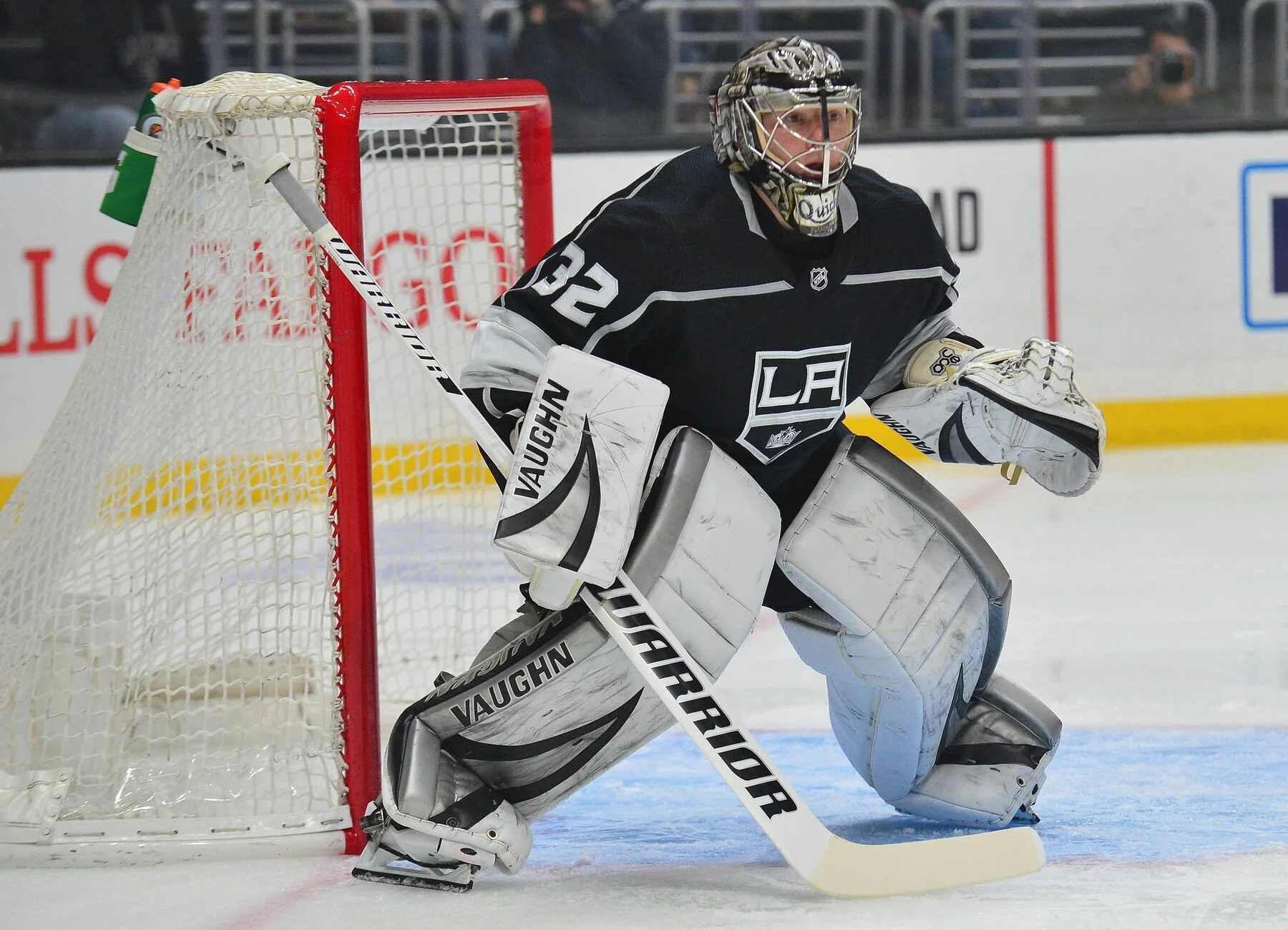March 22, 2021 | 9:50pm ET
BY Dennis Bernstein, The Fourth Period
LAK AT 30: PACK MENTALITY
LOS ANGELES, CA — With the Los Angeles Kings at the 30-game mark of the shortened 56-game NHL season, the next series of games are critical.
With the team on the outside looking in at a postseason berth in the Honda West, trailing the fourth place St. Louis Blues by five points with a game-in-hand and in need of another winning streak like the six-game streak that elevated them to the pack chasing the fourth seed, the next half-dozen games (a pair of home-and-home against San Jose and two against Vegas) could be placed in the “must-win” category.
But one thing we’ve learned in this unique season is that unless you’re Ottawa, Buffalo or Detroit, you’re going to be within striking distance of the playoffs far longer than in the normal 82 game chance. Every game is a four-point game, the opportunity to gain ground is there every time a team steps to the ice given the lack of inter-division play.
With 26 games remaining, Kings fans should be excited not only at the prospect of having their team exit the conversation about the first-overall draft pick this summer but being on the verge of discovering how this still-developing team will respond to playing games of consequence late in the season (yes, it is late in the season. In a normal 82 season, 26 games remaining is the equivalent of being two weeks from the trade deadline).
This is the point where Head Coach Todd McLellan will ask for more from his team when the games really count and aside from the Core Five (whose numbers may thin soon), it’s the first time they will be asked to respond at the highest level of play. It’s the most exciting time since the 2017 post-season due to the fact that a level of truth will be told finding out which players will flourish and which will fail, the next step in the franchise’s progression and the ability of the developing players who are increasingly impactful to the future of the franchise.
THE COIN HAS TWO SIDES
Some thoughts on the good and not-so-good...
The good: Pack Mentality. Short of the bottom falling out over the final 26 games, Los Angeles will be in the pack of teams chasing the playoffs. You can debate the value of landing the four seed in the West and with the caveat of knowing a team would have to be Buffalo Bad to be out of the race, their standing is a significant win.
The not-so-good: A Cut Below. If you’ve watched the games against the top three in the West – Vegas, Colorado, and Minnesota – you know the reason why Los Angeles is battling for the fourth seed and not challenging for the top of the division. There is a significant talent gap that must be addressed and closed to get back to contender status.
The good: Just Win, Baby. The path to 56 is littered with winnable games, 6 vs, San Jose, 5 vs. Anaheim, 4 vs. Arizona. That’s more than half the remaining games and eases the pain of four more against both Vegas and Colorado.
The not-so-good: There is A LOT of hockey remaining. The first 30 Kings games took 67 days to play, the final 25 (one game v STL needs to be rescheduled) will take 48 days. Keep an eye out for how far the Toddfather leans on Anze Kopitar and Drew Doughty from a time-on-ice perspective.
The good: Glad about JAD. Jaret Anderson-Dolan’s third cup of coffee in L.A. is a robust one. While I don’t expect the point-per-game pace to continue, he’s galvanized the bottom-nine forwards with his speed, skill and determination. And don’t forget the forgotten man on the same line. Trevor Moore, who is establishing himself as a reliable bottom-six winger, may start reminding people of another recently departed Trevor.
The not-so-good: Gabe Regressed. If Anderson-Dolan is emerging, then Gabriel Vilardi is submerging. Benched for a long stretch in both the San Jose and Vegas games last week and starting Sunday’s matinee against Vegas on the fourth line, McLellan has resorted to a strategy of both limiting his time and publicly criticize him – “he needs to be factor in the game.” You can point to the wingers he’s playing with as a function of the lack of production, but he owns the fact that he’s produced as much as Moore.
The good: Drew All Grown Up. The numbers are way better this season and with the understanding the production is heavily skewed towards the powerplay, the biggest impression Drew has made is in the leadership department. While he still throws out golden one-liners from time-to-time, his maturity from precocious hockey savant to a veteran who understands how his leadership impacts the next generation of blueliners.
The not-so-good: Third Pair Blues. From a time-on-ice perspective, the L.A. third pair is Sean Walker and Olli Maatta. As Walker tries to regain the form before the gruesome injury he suffered in Minnesota, Maatta’s upper-body injury suffered Sunday night and mindful of the aforementioned compacted schedule, what Los Angeles gets from its third pair defensive combination will be a factor in the playoff hunt.
The good: Roy Cashes In! Matt Roy signed a three-year extension, a tad bit over $3 million on AAV. A great personal and organizational achievement for the former 194th overall pick in 2015.
The not-so-good: Alex Cashes Out? I have to admit I’m a bit surprised Roy got his extension before Alex Iafallo did . . . and probably Alex is, too. Assuming the intention is still to bring back the Western New York native, the comparable on Iafallo is Toronto’s Zach Hyman, who will likely land well over $4 million per on his next deal.
TUGGING AT HEART STRINGS
While Los Angeles doesn’t look to be a trade deadline buyer, it doesn’t mean there won’t be activity by the front office by the April 12th deadline. The improved play has drawn notice from other GMs around the NHL and specifically, two of the Core Five may be in play.
Dustin Brown continuing his renaissance season has elevated him to the status of viable option for a contending team’s Stanley Cup run. His contract, once thought to be an anchor, is now a value deal helped by the fact that the Kings robust salary cap space allows the option to either retain some salary or take on a “bad” contract. Brown has a limited no-contract clause and with just one season remaining on his deal, the combination of his leadership, toughness around the net and renewed productivity checks all the boxes for a potential Cup run.
One team is an obvious landing spot for Brown – the New York Islanders, who were on the wrong end of a body blow when captain Anders Lee’s season ended with an ACL injury. Brown isn’t Lee, but what he is, is the most affordable and likely gettable player on the market. He’s not the only option for the Islanders (Kyle Palmieri, Mikael Granlund, Taylor Hall), but is having the best season of any options.
The other player who has drawn attention is at the other end of the spectrum, goaltender Jonathan Quick. Though the Los Angeles net has not been handed over to Cal Petersen by Todd McLellan, the younger netminder is clearly the better goaltender. Some say that Quick is done and isn’t close to the Conn Smythe winner he once was and they’re right.
But could he backstop an offensively gifted team to a Cup? Is there one last big run in him before he hangs up his pads? Can he prove the Toby Keith lyric true, “I ain’t as good as I once was but I’m as good once as I ever was?”
There is another layer moving of two individuals who are part of the soul of the championship seasons. With the Los Angeles fan base growing more optimistic with each winning play the kids make, moving on from either core player would take an emotional toll but with still no fans in the buildings, the blow of either’s departure could be softened.
Setting aside the emotional toll and with the understanding that the front office needs to take the emotion out of any decision, would it be in the best interest of the team to move these players (Brown more so than Quick because of his level of production and lack of comparable replacement player) while they attempt to chase the Blues for the fourth playoff spot?
With some runway left in the season, there is time to wait and see if Los Angeles stays within striking distance of the postseason. If the playoffs aren’t realistic in the next two weeks, then it’s time to consider all scenarios.
THE HORIZON BECKONS
As the off-season horizon draws closer, the speculation increases as to what moves the L.A. front office could make to continue to the climb back to contention. In both video and writing, I’ve mapped out the assets at the team’s disposal to make moves of significance to upgrade the roster.
The reality is the Kings are in the most unique of positions – in a window with the ability to pull off any trade or any free agent signings this off-season. To have the table set in this way in a flat cap era puts them in a position of strength to make moves you’re likely not to see again.
But will they?
While I advocate the time has drawn nigh to be aggressive and will point to the Minnesota Wild adding one dynamic player (Kirill Kaprizov) to galvanize an average roster to a playoff team, I appreciate the other side of the argument – to stand pat, see how things develop next season with the developing talent and then act accordingly.
But the argument “don’t add because the team is not ready to win” is a broad generalization that makes little sense.
Yes, it makes little sense for the Kings to use their resources to add Kyle Palmieri or Mattias Ekholm, but it’s never the wrong time not to add controllable talent to a team that has grasped what McLellan has taught, one that is starting to forge an identity. Now is the time to build off this platform. Which team isn’t ready to add Filip Forsberg, Rasmus Dahlin or Jack Eichel from a talent perspective?
As for who might have to be bargained for to acquire such talent, despite his significant challenges over the past few weeks, my guess is that to extract Gabriel Vilardi from Los Angeles would require a team to dig the deepest in its pockets, if at all. It’s my belief that because of the flashes and glimpses he shows, the franchise remains aligned that he has the highest ceiling.
I can throw darts at the prospect depth chart to guess who may stay and who may go if this is the summer of talent bliss, but the big question is, what is the philosophy this summer? Standing pat versus activating assets and weaponization of cap space.
To me, it’s checkers versus chess. It’s time to move the King(s).
Dennis Bernstein is the Senior Writer for The Fourth Period.
Follow him on Twitter.
Past Columns:
Mar. 10, 2021 - Report card time in Los Angeles
Feb. 25, 2021 - The Power of 18



